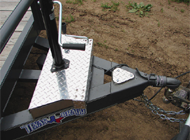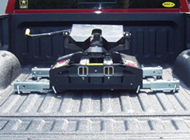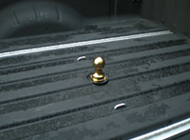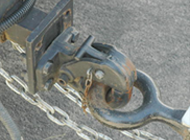Conventional Bumper Pull Hitch

A conventional hitch setup (commonly referred to as "bumper pull") uses a ball and socket joint to secure the trailer to the truck. On some light pickups, the ball may be mounted directly to the bumper. Since this mounting method greatly diminishes tow capacity, most tow packages come with a receiver hitch mounted between the rear frame rails of the truck, which most commonly accepts a 2" or 2 1/2" hitch. Hitch balls are available in 1 7/8", 2", 2 5/16", and 3" sizes (3" hitch balls are relatively rare). The size of the ball depends on the size/weight of the trailer. Many small ATV and boat trailers utilize a 1 7/8" ball, while most travel trailers and equipment haulers require a 2 5/16" ball. The size of the hitch ball MUST match the size of the socket hitch on the trailer. For instance, a trailer with a 2" socket can only be towed with a 2" ball. Likewise, a 2" ball may not be used to haul a trailer with a 2 5/16" hitch.
Conventional Hitch Advantages |
Conventional Hitch Disadvantages |
• Allows for full use of pickup bed storage space.
|
• Tow weight restrictions (most bumper pull trailers are limited to 10,000 lbs). |
• Common, simple design. Affordable components, most pickups come ready to tow. |
• Excessive leverage on the rear of a vehicle can reduce handling performance. |
• Bumper pull trailers can be towed by cars, vans, SUVs, & pickups (other hitch types require a pickup & bed space). |
• Some trailer manufacturers, for reasons we will never understand, build trailers so that the jack handle hits the tailgate when it is lowered, rendering any available bed space useless. |
Weight distribution hitches and sway bars are available for conventional tow setups and are highly recommended investments. Weight distribution hitches, commonly seen on travel trailers, distribute/transfer a significant amount of weight off the rear of the vehicle (essentially reducing tongue weight), while sway bars minimize a trailer's side-to-side motion (wandering) while driving. Both help to increase ride quality and safety while towing with a bumper pull setup.
5th Wheel Hitch

5th wheel hitches mount in the bed of a truck and utilize a plate and pin mounting system. The 5th wheel hitch is the connection of choice for tractor-trailers. 5th wheel hitches are commonly used on recreational vehicles (travel trailers, toy haulers, etc). They center the weight of a trailer over the rear axles of a truck, as opposed to on the bumper of a truck. Today's 5th wheels offer multi-axis tilting to ensure maneuverability and comfort. Their adjustability allows for use in any wheelbase configuration, though they do consume a large volume of bed space (many are removable, but the inconvenience still exists).
5th Wheel Hitch Advantages |
5th Wheel Hitch Disadvantages |
• In some instances, passengers can ride in a 5th wheel so long as there is a method of communication between the tow vehicle and RV (depending on local laws). |
• Bulky hitch takes up a significant amount of bed space.
|
• Easy to hitch up a trailer with 1 person. |
|
• Increased ride comfort over and better maneuverability than a conventional hitch system. |
Gooseneck Hitch

A gooseneck hitch setup uses a ball and socket connection that is mounted in the bed of a vehicle (above the rear axle). The ball can typically be removed or stored so that bed space is not consumed while the truck is not towing. Gooseneck hitches are most commonly used in agricultural and construction applications (equipment & material hauling trailers). Gooseneck hitches require either a 2 5/16" or 3" ball. It is fairly common to convert a 5th wheel into a gooseneck. Goosenecks offer great maneuverability, handling, and are available with large tow capacities.
Gooseneck Hitch Advantages |
Gooseneck Hitch Disadvantages |
• Large tow capacities available, weight distributed over the rear axle. |
• Unlike a 5th wheel, connection location is fixed over the rear axle and not adjustable. |
• Great maneuverability and handling. |
• Trailer takes up bed space when in use.
|
• Does not take up valuable bed space when not in use. |
While 5th wheel to gooseneck conversions are available, the following obstacles may arise when converting:
• Marginally rougher ride.
• Excessive leverage on the joint where the gooseneck conversion replaces the 5th wheel pin (some 5th wheel hitches are not engineered for such loading at this point).
• Possible cab damage in short beds since the location of the gooseneck ball is not adjustable like a 5th wheel hitch is (common when converting recreational vehicles).
• If you purchased a brand new trailer, this may void the trailer's warranty.
Pintle Hitch

Pintle hitches are commonly found on class 5-8 trucks. A pintle hitch system uses a hook and a ring as a means of connection. It is an extremely strong system, often found on large agricultural and construction equipment (generators, equipment haulers, pumps, transfer dumps, etc). You'll see pintle hitches mounted to the rear of most dump trucks and tractor-trailers. Handling and maneuverability of a pintle hitch trailer is similar to a conventional setup.
Gooseneck Hitch Advantages |
Gooseneck Hitch Disadvantages |
• Large tow ratings available. |
• Weight distributed on the rear of the vehicle. |